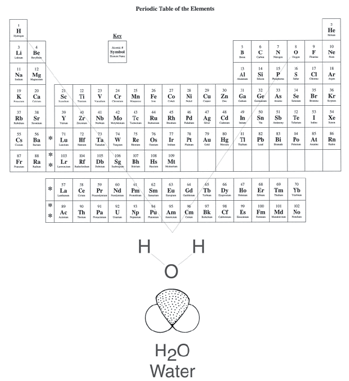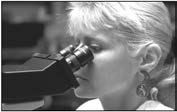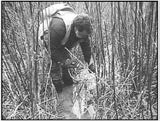Monday
Day 5
Lesson 4
Tuesday
Activity 1: Different Doses for Different People
Activity 2: omit
Day 6
Activity 3: The Chemical Caffeine: How Do You Respond?
Wednesday
Day 7
Lesson 5
Thursday
Activity 1: People at Risk
Activity 2: What Is Your Risk?
Day 8
Lesson 6
Friday
Activity 1: The Field Trip
Activity 2: What Can I Do?
17
Using the Student Lessons
Chemicals, the Environment, and You
Table 9. Master list of supplies for Chemicals, the Environment, and You, based on a class of 30 students, by lesson (L) and activity number (E, extension activity).
L1 L1 L1 L1 L2 L2 L2 L2 L2 L3 L3 L4 L4 L4 L4 L5 L5 L5 L6 L6
Lesson (L)
-1
-2 -3 -E -1 -2
-3
-4 -E -1 -E -1 -2
-3
-E -1 -2 -E
-1
-2
Beaker (50-mL)
1
60
1
Beaker (100-mL)
10
1
Beaker (1000-mL)
3
4
or large jars
Caffeinated soft
30
drink (12 oz.)
Chemicals
(variety)
P
P
Clear containers
3
(different sizes)
Clock with
second hand
P
Clothing
(variety)
P
Coin (only for
30
print version)
Computer with
Web access
P
P P
P
P
P
P
P
Current events
stories
P
P
Eyedropper
P
10
P
Food coloring
(blue)
P
Graduated
cylinder
P
10
(50-mL)
Graduated
cylinder
10
(10-mL)
Index cards
(4 x 6)
P
Jar with lid
(50 mL or larger)
1
18
L1 L1 L1 L1 L2 L2 L2 L2 L2 L3 L3 L4 L4 L4 L4 L5 L5 L5 L6 L6
Lesson (L)
-1
-2 -3 -E -1 -2
-3
-4 -E -1 -E -1 -2
-3
-E -1 -2 -E
-1
-2
Latex gloves,
pair
P
30
P
P
Masking tape
P
Overhead
markers
P
P
Overhead
projector
P
P
P
P
P P
P P P
Paper napkin
(one-ply,
120
12 x 115/8 in.)
Permanent
10
marker
Plain paper
P P
Plastic resealable
1
60
sandwich bag
Poster board,
1
white
Purified water
P
P
Radish seeds
P
600
Red marker (only
1
for print version)
Safety glasses
P
30
Science
30
notebook
P
P P
P
P
P
Shoe box (large
1
with cover)
Transparency
P
P
P P
Tray
10
19
Using the Student Lessons
Using the Web Site
The Web component of Chemicals, the
they do not allow all students to experience the
Environment, and You is a wonderful tool that
in-depth discovery and analysis that the Web site
you can use to help organize your use of the
was designed to stimulate.
module, engage student interest in learning, and
help orchestrate and individualize instruction.
If you are teaching all six lessons as a unit, we
The site features simulations, animations, and
recommend that you keep your students in the
videos that articulate with the lessons. To access
same collaborative groups for all of the activities.
the curriculum’s home page, go to http://science.
This will allow each group to develop a shared
education.nih.gov/supplements/chemicals. (If your experience with the software and with the ideas
classes don’t have access to the Internet, you
and issues that the activities present. A shared
can use the print alternatives included with
experience also will enhance your students’
the lessons.)
perceptions of the lessons as a conceptual whole.
Hardware and Software Requirements
If your student-to-computer ratio is greater than
The Web site can be accessed with any computer
six students to one computer, you will need to
browser. Adobe Flash Player should be installed
change the way you teach the module from the
on the hard drive of each computer that will
instructions in the lessons. For example, if you
access the site. It’s freely available at http://get.
have only one computer available, you may want
adobe.com/flashplayer/.
students to complete the Web-based work over
an extended time period. You can do this in
Getting the Most out of the Web Site
several ways. The most practical one is to use
The ideal use of the Web site requires one
your computer as a center along with several other
computer for each student group. However, if you
centers at which students complete other activities.
have only one computer available, you can still
In this approach, students rotate through the
use the site. You can, for example, project the
computer center, eventually completing the Web-
monitor image for the whole class. If you do not
based work you have assigned.
have access to the Web site, you can use the print-
based alternative provided for each Web activity.
A second way to structure the lessons if you have
only one computer available is to project the
Collaborative Groups
monitor image for the whole class to see. Giving
We designed many of the activities in this
selected students in the class the opportunity
module to be completed by groups of students
to manipulate the Web activities in response to
working together. Although individual students
suggestions and requests from the class can give
working alone can complete many of the specific
students some of the same autonomy in their
steps, this strategy will not stimulate the types
learning they would have gained from working in
of student-student interactions that are one of
small groups.
the goals of active, collaborative, inquiry-based
Web Activities for People with Disabilities
learning. Therefore, we recommend that you
organize collaborative groups of between two and
The Office of Science Education provides access
six students each, depending on the number of
to the Curriculum Supplement Series for people
computers available. Students in groups larger
with disabilities. The online versions of this series
than this will have difficulty organizing the
comply with Section 508 of the Rehabilitation Act.
student-computer interactions equitably, which
If you use assistive technology (such as a Braille
can lead to one or two students’ assuming the
or screen reader) and have trouble accessing
primary responsibility for the computer-based
any materials on our Web site, please let us
work. Although large groups can be efficient,
know. We’ll need a description of the problem,
21
Chemicals, the Environment, and You
the format in which you would like to receive
Contact us at
the material, the Web address of the requested
supplements@science.education.nih.gov
material, and your contact information.
or
(301) 402-2469
22
L E S S O N 1
Chemicals,
Engage
Chemicals,
Everywhere
Overview
At a Glance
Students divide substances into categories: made of chemicals/not made
of chemicals, synthetic/naturally occurring, and toxic/nontoxic. When
the teacher reveals that all the substances are made of chemicals, students discuss how their concept of what a chemical is might differ from the
scientific definition. Students observe a mystery chemical and determine
what precautions they might need to take when handling an unknown
substance. Then, students read case studies of real exposures to chemicals.
Major Concepts
Everything in the environment is made of chemicals. Both naturally
occurring and synthetic substances are chemical in nature. People are
exposed to chemicals by eating or swallowing them, breathing them,
or absorbing them through the skin or mucosa, and they can protect
themselves from harmful chemicals by blocking these routes of exposure.
Objectives
After completing this lesson, students will
• understand that everything in their environment is made of chemicals;
• indicate that both naturally occurring and synthetic substances are
chemical in nature;
• recognize that their view of a chemical as “bad” or “good” relates to
their perception of a chemical’s potential toxicity to humans or other
living organisms;
• realize that toxicologists study chemicals to find out if they are harmful to living organisms;
• understand that people are exposed to chemicals by eating or
swallowing them, breathing them, or absorbing them through the skin
or mucosa; and
• demonstrate that people can protect themselves from harmful chemicals
by blocking these routes of exposure.
23


Chemicals, the Environment, and You
What Is a Chemical?
Background
Simply stated, a chemical is any substance that has a defined molecular Information
composition. Molecules, which are the smallest units into which a
compound can be divided and still be that compound, can be made up of
one or more elements. Sometimes, the elements are the same, such as in
oxygen: Two oxygen atoms are chemically bonded together to form the
gas oxygen, or O . Sometimes, the elements that form molecules are of
2
different types, such as those in water: Two hydrogen atoms combine with
one oxygen atom to form a molecule of water, or H O. All forms of matter
2
are made of one or more of the more than 100 elements combined in many
different molecular combinations. This means that all forms of matter are made of chemicals.
2
The Science of Toxicology
Long ago, humans observed that some chemicals derived from nature were
poisonous. Poisonous chemicals produced naturally by living organisms
Paracelsus.
(such as plants, animals, and fungi) are called toxins. Historically, (Reproduced with the permission
knowledge of toxins was a powerful tool to use against enemies: Many
of the Albertina Wien (Vienna).)
24
murderers in ancient Greece and later throughout Europe used toxins
(Klassen, 2008). A significant contribution to the field of toxicology was made by the scientist Paracelsus (1493–1541). He recognized that the same chemical could have both therapeutic (medicinal) and toxic (poisonous)
properties depending on how much of it was used. His work paved the way
for the concept of the dose-response relationship (see Lesson 3 for more
information about dose and response) (Klassen, 2008; Gilbert, 2004).
With the onset of the industrial revolution and the emergence of the science of synthetic chemistry, a variety of new chemicals was made by humans.
It is estimated that more than 65,000 chemicals have been manufactured
for commercial use in industrialized countries (Eaton and Gallagher, 1997). Whether on purpose or not, humans come into contact with these
chemicals during manufacturing, handling, or consumption. Exposure to a
vast array of synthetic chemicals can occur when a person ingests food or drink, works in an agricultural setting with pesticides, or lives in a home among solvents, paints, plastics, and fuels. Although many of the chemicals greatly benefit us, some can have a toxic effect on human systems. These
substances are called toxicants, a broad category that includes naturally occurring toxins.
How do people know if a chemical is toxic? The science of toxicology
informs them of the nature of poisons. A toxicologist is a scientist who is trained to study the harmful effects of chemicals on living organisms. These harmful effects can include death, but not all toxicants are lethal. Some other harmful effects that toxicologists study are disease, tissue damage, genetic alterations, and cancer. Because there are so many ways that
toxicants can affect living things and there are so many different kinds of chemicals in the environment, toxicology is a very broad science and there are many different kinds of toxicologists (Klassen, 2008).
Routes of Exposure
Toxicants can harm an organism only if they are absorbed by the organism
and reach the organs that are the target of their toxicity. This can happen through three routes:
• ingestion,
• inhalation, and
• absorption through the skin (Gilbert, 2004).
In humans and other animals, toxicants usually affect one or more target
organs such as the lungs, skin, or gastrointestinal tract. For example, if a person inhales asbestos fibers, the fibers get stuck in the airways of the lungs and irritate the lung lining, causing lung impairment over time.
Dermatitis can result if the asbestos fibers irritate skin cells.
Sometimes the toxicant crosses from the external environment of the lung, skin, or gastrointestinal tract into the bloodstream (Klassen, 2008). Many parts of the human body are designed to absorb chemicals quickly and
effectively. The stomach, intestines, and colon absorb nutrients from our diet. These organs easily absorb nutrients and other chemicals because of 25
Student Lesson 1


Chemicals, the Environment, and You
What Do Toxicologists Do?
Descriptive toxicologists evaluate the toxicity of drugs, food additives, and other products.
They ask the question, What happens if …? about the amount of a toxicant and the response that a living system has to the toxicant. The descriptive toxicologist might work in a pharmaceutical laboratory or in an academic setting doing data analysis, animal testing, and/or human clinical trials (Society of Toxicology, 2012).
Mechanistic toxicologists study how a chemical
causes toxic effects on living organisms. They
study biomedical research, biochemistry, and
physiology to understand how a chemical is
absorbed, distributed, and excreted. In order
to develop antidotes, a mechanistic toxicologist
uses information about how a chemical harms an
organism. This kind of toxicological work is often
done in an academic setting or in private industry
(Society of Toxicology, 2012).
Photo: Corel
Clinical toxicologists are usually physicians interested in the prevention, diagnosis, and treatment of poisoning cases. Clinical toxicologists specialize in toxicology issues concerning drugs used for treatment, such as side effects and overdoses; drugs of abuse, such as alcohol and cocaine; and accidental poisonings. These toxicologists have specialized training in emergency medicine and poison management. Veterinarians can be clinical toxicologists who study poisons in animals (Society of Toxicology, 2012)
Forensic toxicologists study the application of toxicology
to the law. They work with pathologists and law
enforcement officers at a crime scene. The forensic
toxicologist uses chemical analysis to help establish the
cause of death and determine the circumstances of death
in a postmortem investigation (Klassen, 2008)
Environmental toxicologists study the effects of pollutants
on organisms, populations, ecosystems, and the biosphere.
Toxicologists concerned with the effects of environmental
Photo: Cameron Davidson
pollutants on human health fit into this group. Most
commonly, however, environmental toxicologists study
the impacts of chemicals on nonhuman organisms such as fish, birds, terrestrial animals, and plants (Klassen, 2008).
Regulatory toxicologists use scientific data to decide how to protect humans and animals from excessive risk. Regulatory toxicologists aim to protect the public from chemical exposure by establishing regulatory standards for food, drugs, water, air, and insecticides, to name only a few. Government bureaus such as the U.S. Food and Drug Administration (FDA) and the U.S. Environmental Protection Agency (EPA) employ regulatory toxicologists (Klassen, 2008; Society of Toxicology, 2012).
26
their large surface area, thin diffusion distance, and high blood flow. The lungs are also designed for rapid absorption. Chemicals that are inhaled
are quickly absorbed into the bloodstream through the thin walls of the air sacs in the lungs. The skin protects the body from harmful agents in the
environment. However, the skin is in direct contact with the environment.
While the dense outer layer of skin cells is a good barrier to chemical
absorption, it is not perfect, even when intact. When the skin is cut or
abraded, it absorbs chemicals very rapidly (Project Greenskate, 2000).
Students’ Misconceptions about Chemicals
Students often harbor misconceptions about chemicals. When asked what
a chemical is, rather than define the word, students tend to give examples of synthetic, toxic chemicals like pesticides. When asked to name some
things made of chemicals, students list items such as shampoo, window
cleaner, processed foods, and “fake sugar” (aspartame). Students believe
that chemicals pollute rivers and air. Students often do not realize that natural substances in the world around them also are made of chemicals.
When asked if it would be better if there were fewer chemicals in the world, one student replied that fewer human-made chemicals would mean less
pollution. When pressed, students will agree that some synthetic chemicals, like a pain reliever, can be good; however, students also recognize that even
“good” chemicals like pain relievers can be toxic if a person takes too much.
Notes about Lesson 1
The purpose of this lesson is to help move students from the view that
chemicals are toxic, synthetic substances that are bad for human health
and the environment to the more inclusive view that all things in the
environment, including their bodies, are made of chemicals. Some of both
naturally occurring and synthetic chemicals can have a detrimental effect on human health and the environment, but many do not. Those that have
a harmful effect on human health do so because they get into the body
through inhalation, ingestion, and absorption.
27
Student Lesson 1
Chemicals, the Environment, and You
In Advance
Web-Based Activities
Activities 1, 2, and 3 have Web components.
Materials and Preparation
Photocopies and Transparencies
Equipment and Materials
1 copy of Master 1.1 for
• computers, overhead projector
the class
• 12 samples of things made
1 transparency of Master 1.2
of chemicals
(optional)
• 1 set of item cards from
1 transparency of Masters 1.3
Master 1.1
and 1.4
• 8 4-by-6-inch index cards
1 copy of Master 1.5, Case
• blue food coloring
Study #1, for each student;
• 50-mL graduated cylinder
for number of copies of
• 50 mL of purified water
Case Studies #2–5, see
• 50-mL or larger glass jar
Preparation for Activity 3
with a lid
• 1 large shoe box with a lid
• variety of clothing in a large
basket or box
• science notebook for
each student
Notes: Because everything in the environment is made of chemicals, any item will work for the 12 samples. Use the chemicals students test in Lesson 2, Activity 3, plus others that do and do not fit students’ concept of chemicals.
The Master 1.1 item cards depict objects that are too big for the materials table or are potentially dangerous. The jar should fit into the shoebox. The clothing could include, for example, elbow pads, shorts, different kinds of hats, boots, sunglasses, earplugs, mittens, and latex gloves.
Preparation
Activity 1
Arrange for students to have access to computers.
Collect samples of things made of chemicals. Place them on a
materials table.
Tip from the field test: To make gathering the materials easier, ask s







